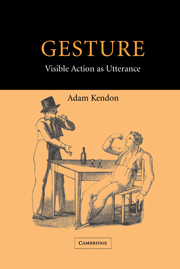Book contents
- Frontmatter
- Contents
- Acknowledgments
- 1 The domain of gesture
- 2 Visible action as gesture
- 3 Western interest in gesture from Classical Antiquity to the eighteenth century
- 4 Four contributions from the nineteenth century: Andrea de Jorio, Edward Tylor, Garrick Mallery and Wilhelm Wundt
- 5 Gesture studies in the twentieth century: recession and return
- 6 Classifying gestures
- 7 Gesture units, gesture phrases and speech
- 8 Deployments of gesture in the utterance
- 9 Gesture and speech in semantic interaction
- 10 Gesture and referential meaning
- 11 On pointing
- 12 Gestures of ‘precision grip’: topic, comment and question markers
- 13 Two gesture families of the open hand
- 14 Gesture without speech: the emergence of kinesic codes
- 15 ‘Gesture’ and ‘sign’ on common ground
- 16 Gesture, culture and the communication economy
- 17 The status of gesture
- Appendix I Transcription conventions
- Appendix II The recordings
- References
- Index
7 - Gesture units, gesture phrases and speech
Published online by Cambridge University Press: 05 February 2015
- Frontmatter
- Contents
- Acknowledgments
- 1 The domain of gesture
- 2 Visible action as gesture
- 3 Western interest in gesture from Classical Antiquity to the eighteenth century
- 4 Four contributions from the nineteenth century: Andrea de Jorio, Edward Tylor, Garrick Mallery and Wilhelm Wundt
- 5 Gesture studies in the twentieth century: recession and return
- 6 Classifying gestures
- 7 Gesture units, gesture phrases and speech
- 8 Deployments of gesture in the utterance
- 9 Gesture and speech in semantic interaction
- 10 Gesture and referential meaning
- 11 On pointing
- 12 Gestures of ‘precision grip’: topic, comment and question markers
- 13 Two gesture families of the open hand
- 14 Gesture without speech: the emergence of kinesic codes
- 15 ‘Gesture’ and ‘sign’ on common ground
- 16 Gesture, culture and the communication economy
- 17 The status of gesture
- Appendix I Transcription conventions
- Appendix II The recordings
- References
- Index
Summary
The survey in Chapter 6 showed that most writers accept that speakers use gestures in several different ways, including deictic reference, as a means of depicting objects or actions and as a way of punctuating, marking up or displaying aspects of the structure of their spoken discourse. However, if we are to have a better appreciation of the significance of this, we need to know in more detail how and when it is that speakers do these things. Without detailed analysis of how speakers deploy gestures as a part of their utterances we shall not have precise ideas about how speech and gesture function in relation to one another. Audio-visual technology, easily available only very recently, and available only to some of the writers whose classification schemes we have considered, now makes possible the kind of descriptive analysis of gesture use that we believe is needed. It is this that will be offered in the chapters that follow: a descriptive survey of gesture use, based upon the analysis of specimens drawn from a large collection of video recordings of occasions of conversational interaction in many different settings.
In this chapter and the next one, we look at aspects of how gesturing and speaking are organized in relation to one another. The units of gestural action we consider are the gesture phrase and the gesture unit.
- Type
- Chapter
- Information
- GestureVisible Action as Utterance, pp. 108 - 126Publisher: Cambridge University PressPrint publication year: 2004
- 2
- Cited by



